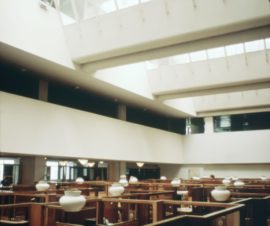- PlaceSeinäjoki
- Completion 1960–1988
- Decade1960s
- PeriodThe rise of the welfare state
- Year of selection1993
The Seinäjoki Civic Centre came about on the basis of two architecture competitions. In 1951 Alvar Aalto won the competition for the church organised by Seinäjoki parish with his proposal “Lakeuksien risti”, and in 1958 he also won the competition for the town hall organised by the town authorities, with his proposal “Kaupungintalo”. The church buildings originally formed an independent totality. Although Aalto did perhaps take these into consideration in the town hall competition, the final Civic Centre became a cohesive entity only in the 1960s after several planning stages.
The Cross of the Plains church was completed in 1960, followed by the town hall in 1962, the library in 1965, the parish centre in 1966 and the state offices building in 1968. The planning of the Civic Centre was continued after Aalto’s death by architect Elissa Aalto, and under her leadership the theatre was completed in 1987.
After World War Two it became evident that the functions in a city were not limited merely to housing, work, recreation and transport as put forward in the modernist urban planning doctrines of the 1930s, but also a sense of community was needed. For this “fifth function” civic centres had to be built as gathering places for the citizens of the city.
In Finland the planning of civic centres was linked strongly, on the one hand, to urbanization and, on the other hand, to the development of the welfare state, at a time when there was sufficient incentive in city centres for both the expansion of the municipal administration and an emerging cultural and leisure services.
The Seinäjoki Civic Centre is a group of public buildings located slightly apart from the rest of the urban structure. More important than the individual buildings is the exterior spaces that they demarcate and frame. The church together with the square delimited by the parish centre constitute a totality reminiscent of an Early Christian basilica and its atrium. The square, stepped to form an auditorium, has been designed so as to hold religious events during the summertime. A forecourt is formed on the north side of the church, terminating in the east with a cross-shaped baptistery and campanile, in accordance with the name of the church. The western end of the forecourt is marked by the town hall and its council chamber which brings to mind the tower of a traditional town hall.
Also the town hall, library and theatre together demarcate the boundaries of a square, intended as a gathering place for the inhabitants of Seinäjoki. The paving of the square continues across the street that cuts through the Civic Centre, thus connecting the administrative and cultural buildings to the church buildings. In the west the perspectival vista across the square between the theatre and the town hall terminates at the state offices building.
Seinäjoki Civic Centre (nowadays known as the Aalto Centre) has mostly been well preserved. The only building whose appearance has been significantly altered is the parish centre: the roof terrace of the wing that demarcates the square in front of the church was converted into an interior space in 1984 (Hannu Valkama Architects). In all buildings the main public spaces have, as a rule, been preserved, including their interior furnishings. Alterations have been carried out, however, in the more conventional office spaces. An era of renovation of the Civic Centre began in the 2010s: the first in turn was the library in 2015 (Mustonen Architects).
Seinäjoki Civic Centre is an exemplary implementation of the post-World War II civic centre ideology and the main symbol of the city. Due to the versatile set of buildings, comprehensive planning and integrated implementation, it is the most representative example of Alvar Aalto’s many, but often unrealized, civic centres.
__________
Penttilä, Jaakko (2004). Seinäjoen kulttuuri- ja hallintokeskus. Rakennushistoriallinen selvitys ja säilyneisyyskartoitus. Painamaton / unpublished document, Alvar Aalto -säätiö.
Penttilä, Jaakko (2009). Kaupungin kasvot. Alvar Aallon kaupunkikeskus Seinäjoella. Diplomityö, painamaton / unpublished document, Tampereen teknillinen yliopisto.
JKMM (2012). ”Seinäjoen kaupunginkirjasto / Seinäjoki Main Library”, Arkkitehti 6/2012, 42–52.



